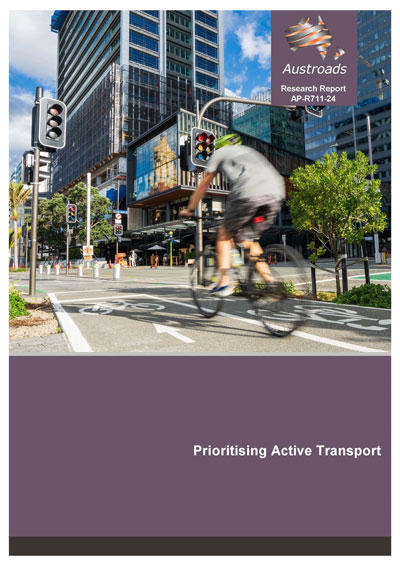Active Travel

- Publication no: AP-R711-24
- ISBN: 978-1-922994-37-0
- Published: 12 June 2024
- PDF (free) Download
This report provides coverage of interventions effective in growing active transport mode share.
A prioritisation framework was developed to select the interventions that are most impactful in boosting active transport mode share. Significant increases in mode share are likely to require ambitious initiatives. Two decades of policy support for increasing active transport mode share may have stopped or slowed falls in walking and cycling levels but has not yet succeeded in achieving widespread and large increases.
In addition to impact, an intervention’s cost, and complexity was also included within the prioritisation framework. For each of the prioritised actions, guidance on their suitability to different geographical contexts has been offered (e.g. inner city, suburban, regional etc.)
This report has found that to grow active transport mode share, a mix of interventions is required, including those that reduce or remove current incentives that encourage car use alongside interventions designed to encourage walking and cycling.
Watch a webinar series presented by Dr Elliot Fishman discussing the research in the report .
- Summary
- 1. Introduction
- 1.1 Purpose
- 1.2 Scope
- 1.3 Methodology
- 2. Active Transport in the Australasian Context
- 2.1 Active transport in the international context
- 2.2 How active transport varies across Australasian cities for commutes
- 2.2.1 Understanding the relationship between trip distance and active transport to work
- 2.3 Active travel participation in Australia – all purpose
- 2.3.1 Walking
- 2.3.2 Cycling
- 2.4 Variations in active transport within the same city
- 2.4.1 Walking to work
- 2.4.2 Cycling to work
- 2.5 How do travel distances vary by mode of transport and trip purpose?
- 3. Barriers to Active Transport
- 3.1 Summary of barriers
- 3.2 Safety
- 3.2.1 Walking
- 3.2.2 Cycling
- 3.3 Security
- 3.4 Need to carry items
- 3.5 Weather
- 3.6 Distance and hills
- 3.7 Social and cultural factors
- 4. Prioritisation Methodology
- 4.1 Intervention categories
- 4.1.1 Land use planning
- 4.1.2 Infrastructure
- 4.1.3 Shared micro-mobility
- 4.1.4 Policies and strategies
- 4.1.5 Education
- 4.1.6 Special events and marketing
- 4.2 Variables included in prioritisation framework
- 4.2.1 Impact
- 4.2.2 Complexity
- 4.2.3 Cost
- 4.3 Approach to ranking actions
- 4.4 Research evidence ranking
- 4.1 Intervention categories
- 5. Locational Context for Recommendations
- 5.1 Inner city
- 5.2 Suburban
- 5.3 Regional – central
- 5.4 Regional – rural
- 6. Results of Prioritisation
- 6.1 Land use planning
- 6.2 Infrastructure
- 6.3 Shared micro-mobility
- 6.4 Policies and sStrategies
- 6.5 Education
- 6.6 Special events and marketing
- 6.7 Expert interview ranking
- 7. Detailed Coverage of Prioritised Interventions
- 7.1 Land use planning
- 7.1.1 Transit oriented development and pedestrian oriented development
- 7.1.2 Car parking supply in the planning system
- 7.2 Cycling infrastructure
- 7.2.1 Cycling networks
- 7.2.2 Bike parking at stations / destination
- 7.2.3 In-building bike parking and end of tripend-of-trip facility
- 7.3 Walking infrastructure
- 7.3.1 Footpath
- 7.3.2 Crossings
- 7.3.3 Placemaking
- 7.4 Shared micro-mobility
- 7.4.1 Bike share
- 7.4.2 E-scooter share
- 7.5 Policies and strategies
- 7.5.1 Public transport integration with walking and cycling
- 7.5.2 Road-user pricing
- 7.5.3 E-bike incentive
- 7.6 Education
- 7.6.1 Travel behaviour change programs
- 7.7 Special events and marketing
- 7.7.1 Ride 2 Work Day / Walk to Work Day / Walk in to Work outOut
- 7.7.2 Ciclovias
- 7.1 Land use planning
- 8. Initiatives Not Included
- 8.1 Infrastructure
- 8.1.1 Pedestrianisation / car freecar-free
- 8.1.2 Super Blocks
- 8.1.3 Motor vehicle speed reduction
- 8.1.4 Car parking cost - on streeton-street parking cost
- 8.1.5 Car parking cost – off streetoff-street taxes and levies
- 8.1.6 Cycling incentives – e-bike trial
- 8.1.7 Parking cash- out scheme
- 8.1.8 Free public transport
- 8.1.9 Car share
- 8.2 Special events and marketing
- 8.2.1 PARK(ing) Day
- 8.2.2 Digital platforms and gamification
- 8.1 Infrastructure
- 9. Recommendations for Austroads Guides
- 9.1 Transit orientated development and pedestrian orientated development
- 9.2 Cycling infrastructure –– bike modal filter
- 9.3 Cycling infrastructure –– bike parking at stations / destinations
- 9.4 Bike share and e-scooter share
- 9.5 E-bike incentive
- 9.6 Travel behaviour change programs
- 9.7 Other initiatives
- References
